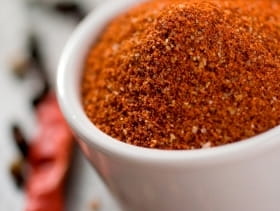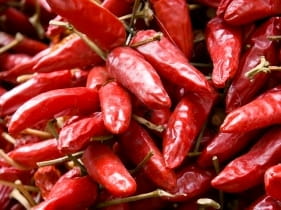Capsaicin: When the "Chili" Is Too Hot

The Bottom Line
Capsaicin, the active ingredient in hot peppers, can be intensely irritating on the skin, in the eyes, to the stomach and gastrointestinal tract, and if inhaled.

The Full Story
Although many people enjoy the spicy heat that chili peppers and cayenne peppers add to food, heat seekers need to be aware of potential hazards.
The source of this flavor in peppers is known as capsaicin. Capsaicin is also found in topical medications used to treat disorders like pain and arthritis and in riot control agents and personal protective agents like pepper spray and pepper mace. This naturally occurring compound works on the body by stimulating pain fibers through the release of somatostatin.
Although usually enjoyable in our food, too much hot pepper can result in nausea, vomiting, abdominal pain, diarrhea and a burning sensation when ingested. During meal preparation, if capsaicin-containing oils get on the skin, it can lead to pain and redness with irritation. And if the pepper juices happen to inadvertently squirt into the eye, intense pain, tearing and redness can result. When inhaled, capsaicin can trigger an asthma attack or respiratory distress in susceptible people.
To help alleviate the burning sensation caused from eating capsaicin, small sips of milk or water may be helpful. If the eye has been affected, irrigation with copious warm water for 15 minutes is the first step. Using cool compresses may also provide relief. If the skin is exposed, warm water flushes, vegetable oil, diluted vinegar with water soaks and an antacid preparation (like Maalox®) applied to the skin may be helpful.
Also, removal from the source is critical. If the person is experiencing any trouble breathing or chest discomfort, call 911. For additional information or questions, call Poison Control at 1-800-222-1222.
Amanda McDaniel-Price, RN, BA, BSN
Certified Specialist in Poison Information
Poisoned?
Call 1-800-222-1222 or
Prevention Tips
- Wear rubber, latex, or nitrile gloves when working with hot peppers.
- Open the windows or use fresh air if preparing or cooking hot peppers.
- Do NOT touch face or eyes after preparing hot peppers.
- If you choose to carry pepper spray, store and use it safely.
This Really Happened
Case 1: A young woman called Poison Control complaining of pain and blistering on her skin after handling hot chili peppers with bare hands an hour before. She had already tried washing with water, milk, and vinegar and had taken ibuprofen. Poison Control recommended applying a liquid antacid to the skin. However, the patient couldn't tolerate the pain and went to an emergency room. In the emergency room her hands were wrapped in gauze soaked in antibiotic ointment. She was given a narcotic pain reliever. The following day in a follow-up call from Poison Control the patient reported that her skin was somewhat improved but that her hands were still red, dry and cracked. She was using a moisturizing cream on the affected areas. Five days later she reported to Poison Control that she was much better.
Case 2: A teenage boy ate some food that had very hot chili peppers in it. He vomited and developed diarrhea and throat irritation. His mother called Poison Control and was advised to give him ice cream or an antacid. Three hours later in a follow-up call from Poison Control his mother said he had Maalox® and ice cream and this seemed to help. The following day his mother reported Poison Control that he was back to normal.
References
Poisoned?
Call 1-800-222-1222 or
Prevention Tips
- Wear rubber, latex, or nitrile gloves when working with hot peppers.
- Open the windows or use fresh air if preparing or cooking hot peppers.
- Do NOT touch face or eyes after preparing hot peppers.
- If you choose to carry pepper spray, store and use it safely.
This Really Happened
Case 1: A young woman called Poison Control complaining of pain and blistering on her skin after handling hot chili peppers with bare hands an hour before. She had already tried washing with water, milk, and vinegar and had taken ibuprofen. Poison Control recommended applying a liquid antacid to the skin. However, the patient couldn't tolerate the pain and went to an emergency room. In the emergency room her hands were wrapped in gauze soaked in antibiotic ointment. She was given a narcotic pain reliever. The following day in a follow-up call from Poison Control the patient reported that her skin was somewhat improved but that her hands were still red, dry and cracked. She was using a moisturizing cream on the affected areas. Five days later she reported to Poison Control that she was much better.
Case 2: A teenage boy ate some food that had very hot chili peppers in it. He vomited and developed diarrhea and throat irritation. His mother called Poison Control and was advised to give him ice cream or an antacid. Three hours later in a follow-up call from Poison Control his mother said he had Maalox® and ice cream and this seemed to help. The following day his mother reported Poison Control that he was back to normal.
